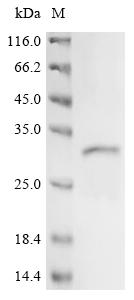Recombinant Human Solute carrier family 22 member 1 (SLC22A1) , partial
CAT:
399-CSB-EP021442HU1-02
Size:
100 µg
Price:
Ask
- Availability: 24/48H Stock Items & 2 to 6 Weeks non Stock Items.
- Dry Ice Shipment: No




Recombinant Human Solute carrier family 22 member 1 (SLC22A1) , partial
- CAS Number: 9000-83-3
- Gene Name: SLC22A1
- UniProt: O15245
- Expression Region: 43-149aa
- Organism: Homo sapiens
- Target Sequence: GFTPDHHCQSPGVAELSQRCGWSPAEELNYTVPGLGPAGEAFLGQCRRYEVDWNQSALSCVDPLASLATNRSHLPLGPCQDGWVYDTPGSSIVTEFNLVCADSWKLD
- Tag: N-terminal 6xHis-SUMO-tagged
- Source: E.coli
- Field of Research: Signal Transduction
- Assay Type: Developed Protein
- Relevance: Translocates a broad array of organic cations with various structures and molecular weights including the model compounds 1-methyl-4-phenylpyridinium (MPP), tetraethylammonium (TEA), N-1-methylnicotinamide (NMN), 4- (4- (dimethylamino)styryl)-N-methylpyridinium (ASP), the endogenous compounds choline, guanidine, histamine, epinephrine, adrenaline, noradrenaline and dopamine, and the drugs quinine, and metformin. The transport of organic cations is inhibited by a broad array of compounds like tetramethylammonium (TMA), cocaine, lidocaine, NMDA receptor antagonists, atropine, prazosin, cimetidine, TEA and NMN, guanidine, cimetidine, choline, procainamide, quinine, tetrabutylammonium, and tetrapentylammonium. Translocates organic cations in an electrogenic and pH-independent manner. Translocates organic cations across the plasma membrane in both directions. Transports the polyamines spermine and spermidine. Transports pramipexole across the basolateral membrane of the proximal tubular epithelial cells. The choline transport is activated by MMTS. Regulated by various intracellular signaling pathways including inhibition by protein kinase A activation, and endogenously activation by the calmodulin complex, the calmodulin-dependent kinase II and LCK tyrosine kinase. Mediates the transport of prostaglandin E2 (PGE2) and prostaglandin F2-alpha (PGF2-alpha) and may be involved in their renal excretion.
- Purity: Greater than 85% as determined by SDS-PAGE.
- Activity: Not Test
- Length: Partial
- Form: Liquid or Lyophilized powder
- Buffer: If the delivery form is liquid, the default storage buffer is Tris/PBS-based buffer, 5%-50% glycerol. If the delivery form is lyophilized powder, the buffer before lyophilization is Tris/PBS-based buffer, 6% Trehalose, pH 8.0.
- Reconstitution: We recommend that this vial be briefly centrifuged prior to opening to bring the contents to the bottom. Please reconstitute protein in deionized sterile water to a concentration of 0.1-1.0 mg/mL.We recommend to add 5-50% of glycerol (final concentration) and aliquot for long-term storage at -20℃/-80℃. Our default final concentration of glycerol is 50%. Customers could use it as reference.
- Molecular Weight: 24.5 kDa
- References & Citations: "Drug specificity and intestinal membrane localization of human organic cation transporters (OCT)." Mueller J., Lips K.S., Metzner L., Neubert R.H.H., Koepsell H., Brandsch M. Biochem. Pharmacol. 70:1851-1860 (2005)
- Storage Conditions: The shelf life is related to many factors, storage state, buffer ingredients, storage temperature and the stability of the protein itself. Generally, the shelf life of liquid form is 6 months at -20℃/-80℃. The shelf life of lyophilized form is 12 months at -20℃/-80℃.
